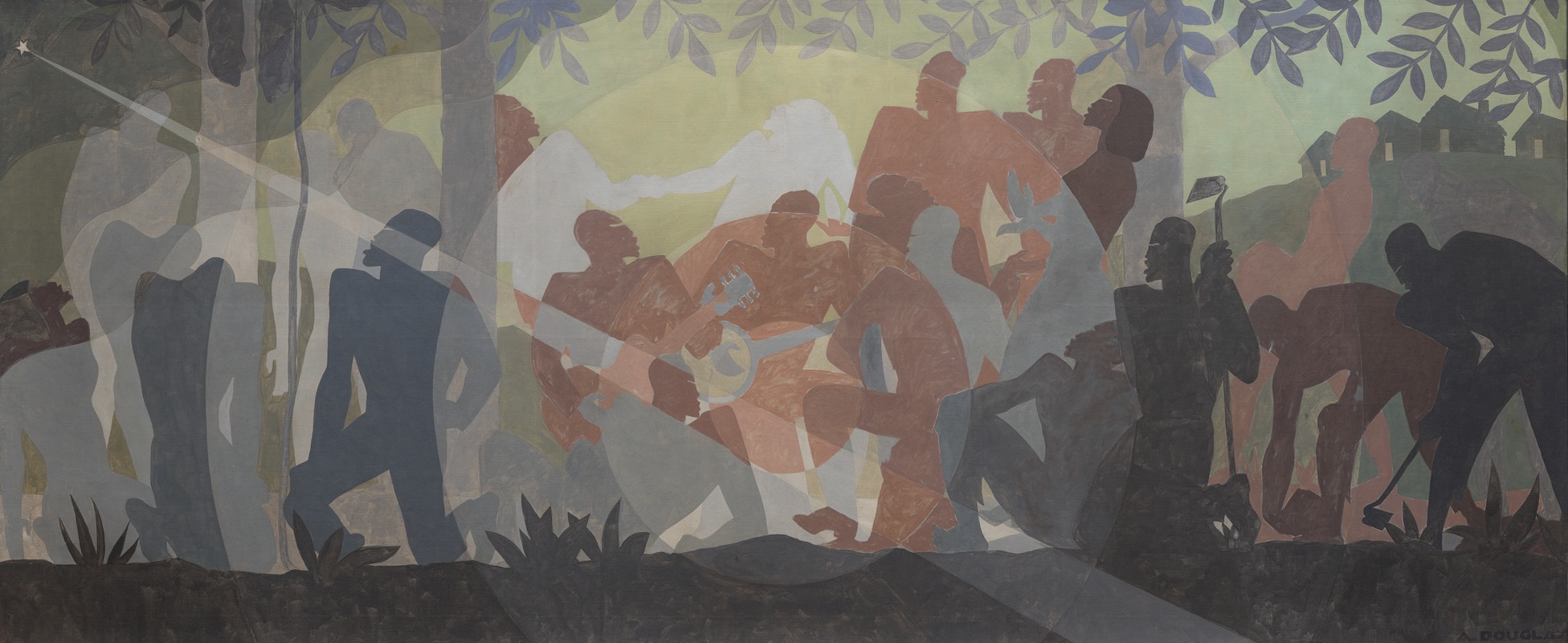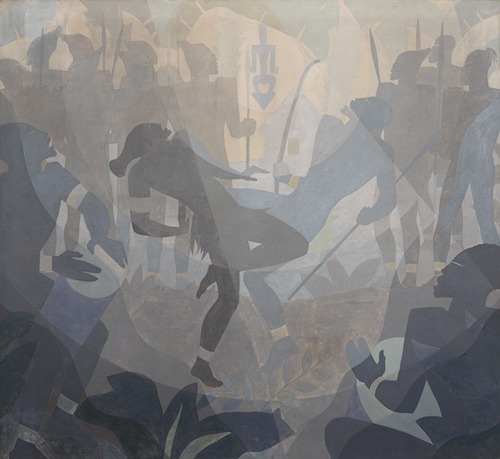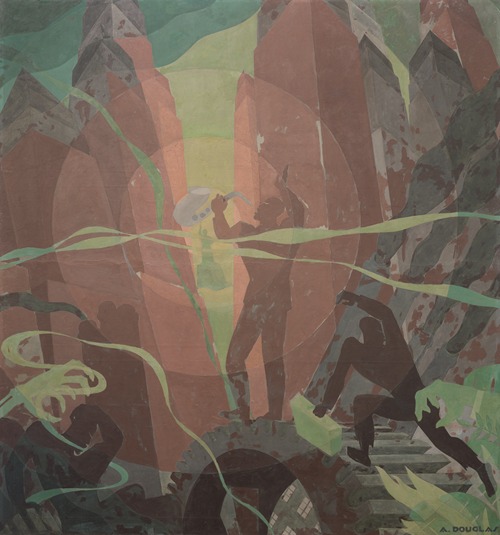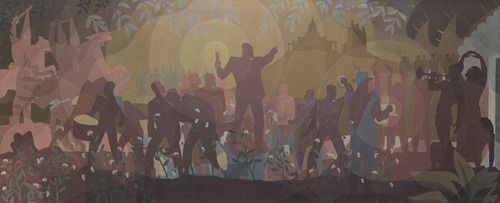

Aaron Douglas was an American painter, illustrator, and visual arts educator. He was a major figure in the Harlem Renaissance. He developed his art career painting murals and creating illustrations that addressed social issues around race and segregation in the United States by utilizing African-centric imagery. Douglas set the stage for young, African-American artists to enter the public-arts realm through his involvement with the Harlem Artists Guild. In 1944, he concluded his art career by founding the Art Department at Fisk University in Nashville, Tennessee. He taught visual art classes at Fisk University until his retirement in 1966. Douglas is known as a prominent leader in modern African-American art whose work influenced artists for years to come.
Aaron Douglas was born and raised in Topeka, Kansas, on May 26, 1899, to Aaron Douglas, Sr, a baker from Tennessee, and Elizabeth Douglas, a homemaker and amateur artist from Alabama. His passion for art derived from admiring his mother's drawings. He attended Topeka High School, during which he worked for Skinner's N|ursery and Union Pacific material yard, and graduated in 1917.
After high school, Douglas moved to Detroit, Michigan, and held various jobs, including working as a plasterer and molding sand from automobile radiators for Cadillac. During this time, he attended free classes at the Detroit Museum of Art before attending college at the University of Nebraska in 1918. While attending college, Douglas worked as a busboy to finance his education. When World War I commenced, Douglas attempted to join the Student Army Training Corps (SATC) at the University of Nebraska, but was dismissed. Historians have speculated that this dismissal was correlated with the racially segregated climate of American society and the military. He then transferred for a short time to the University of Minnesota, where he volunteered for the SATC and attained the rank of corporal. After the signing of the armistice, he returned to the University of Nebraska, where he received a Bachelor of Fine Arts degree in 1922.
After graduating, Douglas worked as a waiter for the Union Pacific Railroad until 1923, when he secured a job teaching visual arts at Lincoln High School in Kansas City, Missouri, staying there until 1925. During his time in Kansas City, he exchanged letters with Alta Sawyer, his future wife, about his plans beyond teaching in a high-school setting. He wanted to take his art career to Paris, France, as many of his aspiring artist peers did.
In 1925, Douglas intended to pass through Harlem, New York, on his way to Paris to advance his art career. He was convinced to stay in Harlem and develop his art during the height of the Harlem Renaissance, influenced by the writings of Alain Locke about the importance of Harlem for aspiring African Americans. While in Harlem, Douglas studied under Winold Reiss, a German portraitist who encouraged him to work with African-centric themes to create a sense of unity between African Americans with art; Douglas would later come to be included in Alaine Locke's The New Negro as Reiss' pupil. Douglas worked with W. E. B. Du Bois, then-editor at The Crisis, a monthly journal of the NAACP, and became art editor himself briefly in 1927. Douglas also illustrated for Charles S. Johnson, then-editor at Opportunity, the official publication of the National Urban League. These illustrations focused on articles about lynching and segregation, and theater and jazz. Douglas' illustrations also featured in the periodicals Vanity Fair and Theatre Arts Monthly. In 1927, Douglas was asked to create the first of his murals at Club Ebony, which highlighted Harlem nightlife.
In 1928, Douglas received a one-year Barnes Foundation Fellowship in Philadelphia, Pennsylvania, where Albert C. Barnes, philanthropist and founder of the Barnes Foundation, supported him in studying the collection of Modernist paintings and African art. During this same year, Douglas participated in the Harmon Foundation's exhibition organized by the College Art Association, entitled "Contemporary Negro Art." In the summer of 1930, he moved to Nashville, Tennessee, where he worked on a series of murals for Fisk University's Cravath Hall library that he described as a "panorama of the development of Black people in this hemisphere, in the new world." While in Nashville, he was commissioned by the Sherman Hotel in Chicago, Illinois, to paint a mural series. In addition, he was commissioned by Bennett College for Women in Greensboro, North Carolina, to create a mural with Harriet Tubman as its primary figure. He then moved in 1931 for one year to Paris, France, where he received training in sculpture and painting at the Académie Scandinave.
Douglas returned to Harlem in the mid-1930s to work on his mural painting techniques. Having joined the American Communist Party at some point upon return, Douglas began to explore more political topics within his art as well. In 1934, he was commissioned by New York’s 135th Street YMCA to paint a mural on their building, as well as by the Public Works Administration to paint his most acclaimed mural cycle, Aspects of Negro Life, for the Countee Cullen Branch of New York Public Library. He used these murals to inform his audiences of the place of African Americans throughout America's history and its present society. In a series consisting of four murals, Douglas takes his audience from an African setting, to slavery and the Reconstruction era in the United States, then through the threats of lynching and segregation in a post-Civil War America to a final mural depicting the movement of African Americans north towards the Harlem Renaissance and the Great Depression. Douglas created a similar series of murals, which included Into Bondage (1936), for the Texas Centennial Exposition in Dallas in 1936. During the height of his commissioned work as a muralist, Douglas served as president of the Harlem Artists Guild in 1935, an organization designed to create a network of young artists in New York City to provide support, inspiration, and to help out young artists during the Harlem Renaissance.
In 1937, the Rosenwald Foundation awarded Douglas a travel fellowship to go to the American South and visit primarily Black universities, including Fisk University in Nashville, Tennessee, the Tuskegee Institute in Alabama, and Dillard University in New Orleans, Louisiana. In 1938, he again received a travel fellowship from the Rosenwald Foundation to go to the Dominican Republic and Haiti to develop a series of watercolors depicting the life of these Caribbean islands.
Upon returning to the United States in 1940, he worked at Fisk University in Nashville, Tennessee, while attending Columbia University Teacher’s College in New York City. He received his Master of Arts degree in 1944, and moved to Nashville, to found and sit as the chairman of the Art Department at Fisk University. During his tenure as a professor in the Art Department, he was the founding director of the Carl Van Vechten Gallery of Fine Arts, which included both White and African-American art in an effort to educate students on being an artist in a segregated American South. He used his experiences as an artist in the Harlem Renaissance to inspire his students to expand on the movements of African-American art. He also encouraged his students to study African-American history to fully understand the necessity for African-American art in predominantly White-American society. Douglas retired from teaching in the Art Department at Fisk University in 1966.
Aaron Douglas died at the age of 79 on February 2, 1979.


